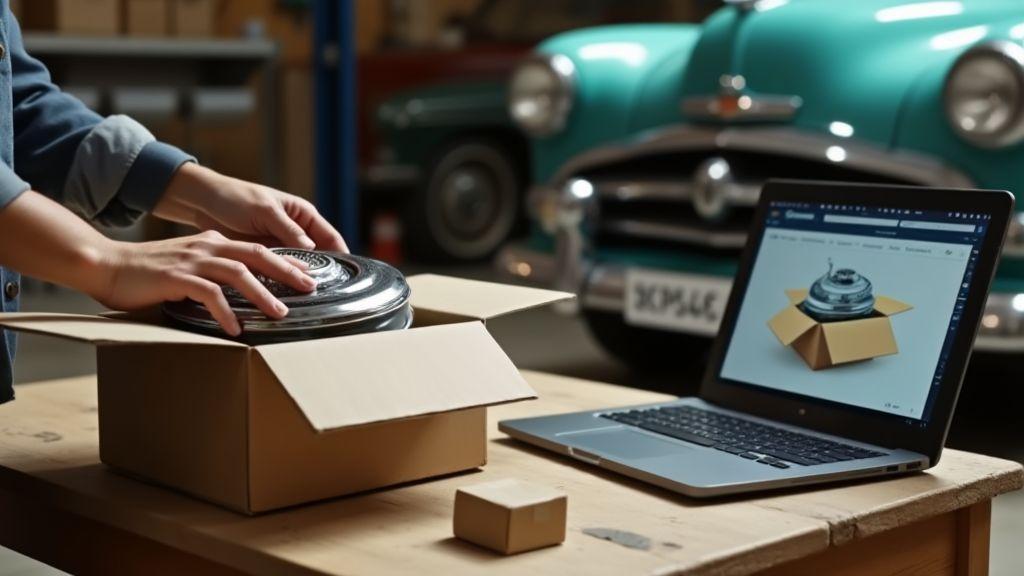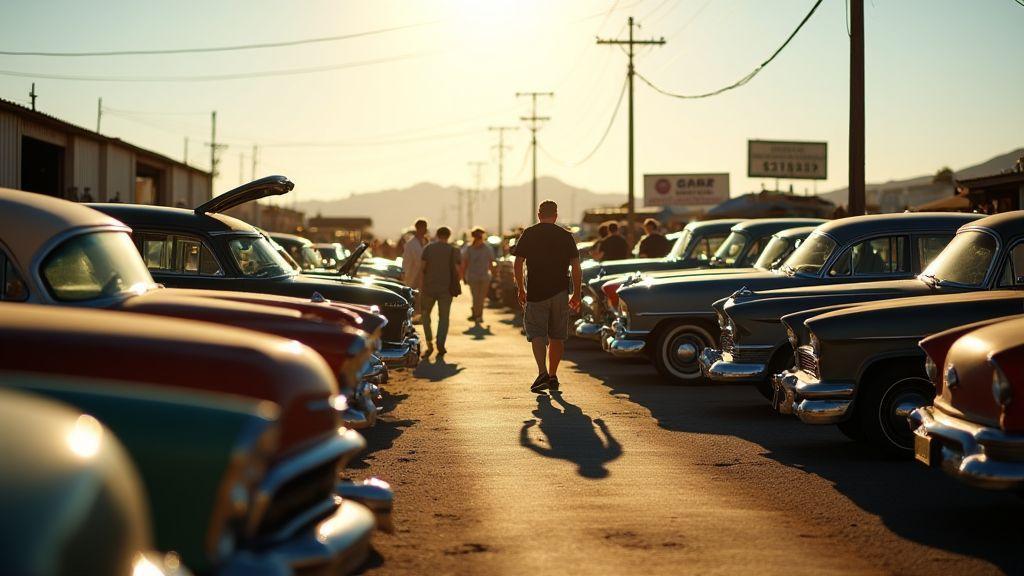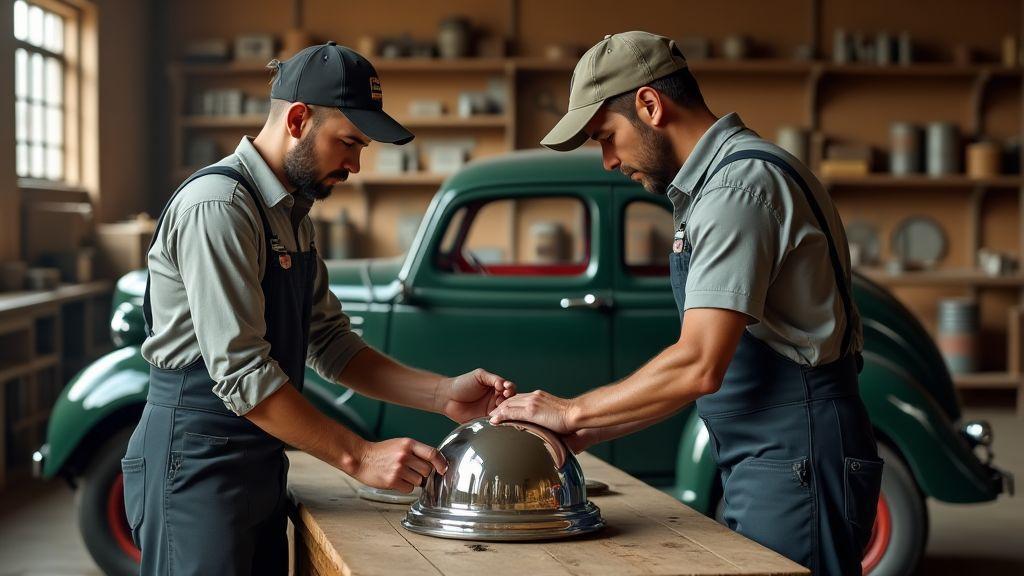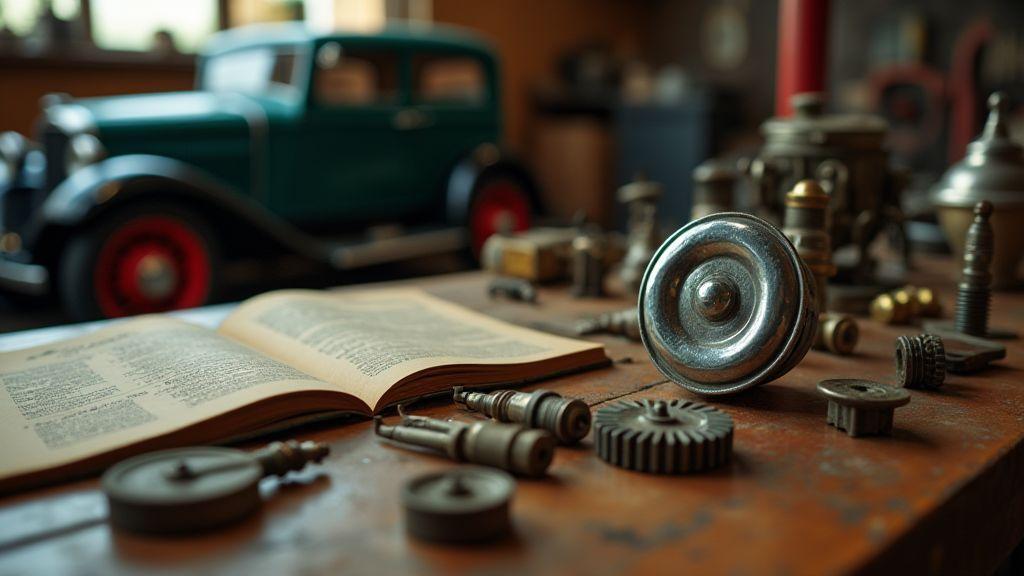How to Find Authentic Parts for Vintage Cars
How to Find Authentic Parts for Vintage Cars is your quick guide to scoring real parts online and in person. Search trusted online marketplaces, specialty forums, and dealer databases. Spot NOS by checking packaging, part numbers, and factory labels. Hit local salvage yards and swap meets with a checklist and a magnet, build relationships with clubs and suppliers, verify authenticity with casting numbers, invoices, and expert appraisals, and compare NOS, used originals, and reproductions to set a smart budget and avoid costly delays.
Key Takeaway
- Look for parts at trusted vintage dealers and car clubs you know
- Check original part numbers and maker marks to make sure the part is real
- Ask for clear photos and proof the part fits your car before you pay
- Compare prices and avoid deals that seem too good to be true
- Have a mechanic or experienced owner check parts when you can

How to Find Authentic Parts for Vintage Cars on trusted online marketplaces
If you’re asking How to Find Authentic Parts for Vintage Cars, treat the listing like a detective story. Look for clear part numbers, crisp photos from multiple angles, and close-ups of stamps or casting marks. Ask the seller for the vehicle ID or manufacturing codes to match fitment. A genuine part will have consistent wear, factory marks, and a provenance—if the seller can tell you where it came from, that helps.
Cross-check every claim with a factory manual, parts book, or trusted forum post. If a part is listed as “original” but shows machining or casting marks that don’t match era tooling, flag it. Use image searches and VIN-based parts diagrams so you’re matching the right item to your car. Don’t skip small details like plug patterns, bolt spacings, or finish—those are where mistakes hide.
Protect yourself with payment and shipping choices that give you recourse. For guidance, see Safe tips for buying parts online. Prefer sellers who accept returns, use tracked shipping, and offer clear refund policies. Review marketplace protections and our terms of use when you’re unsure about a seller’s promises. Save messages and receipts—if something arrives not as pictured, you’ll want proof to get your money back. Patience pays; the right part often shows up after a few good searches and messages.
Search specialty sites and forums to find authentic vintage car parts
Forums and marque clubs are gold mines. Post a photo of the part you need and get answers from people who have taken these cars apart. Marque forums, single-model Facebook groups, and hobbyist boards often list parts for sale before they hit big marketplaces. Members will call out fakes fast, so you get reliable feedback.
Use auction archives and classifieds on niche platforms too. Sellers there tend to include part numbers or origin stories. When someone lists an NOS item, they usually include factory tags or paperwork—shortcuts to authenticating the piece.
Use dealer parts databases and verified sellers to find vintage auto parts online
Dealer parts databases and OEM catalogs help you match part numbers precisely. Many dealerships keep digitized back catalogs or can look up parts tied to your VIN. If a seller’s part number matches the dealer listing, you’re off to a strong start. Ask the dealer to confirm interchange numbers if unsure.
Buy from verified sellers when possible. Marketplaces mark sellers with badges for high feedback and consistent shipping. Verified sellers usually offer returns and reliable descriptions—reducing guesswork and raising your odds of a true original.
Check seller ratings, return policy, and clear photos before you buy
Scan seller ratings and read recent reviews. Check the return window and who pays return shipping. Zoom every photo and ask for close-ups of bolt holes, edges, and any stamps or numbers. Request measurements if you can’t verify fit from photos. If the seller hesitates or avoids questions, walk away—be picky.
How to spot and buy NOS vintage auto parts for true originality
If you want to know How to Find Authentic Parts for Vintage Cars, start with the box. NOS parts usually come in original factory packaging with period graphics, old paper, and faded ink. Hold the box up to light—look for printing techniques from the era, dot patterns, aged glue, or paper that smells like an old garage. These clues show the part sat on a factory shelf, not in a modern warehouse.
Next, check the part for factory marks: stamps, casting numbers, and tiny date codes. Match those numbers to reference guides or factory parts books. If the metal, rubber, or plating shows consistent aging with the label, that’s a good sign. If the part looks brand-new but the box looks ancient, dig deeper—sellers sometimes repackage.
Finally, ask for provenance—receipts, old invoices, or original dealer tags. Be ready to walk away. Authentic NOS is worth a premium, but fakes are common. Trust your gut and verify facts before you spend.
Verify packaging, part numbers, and factory labels for NOS vintage auto parts
Packaging tells a story—original boxes often have factory lot stickers, era barcodes, or part numbers printed in old fonts. Compare fonts and layout to verified photos from factory catalogs. Look for consistent wear where a sticker would peel; new glue or mismatched tape is a warning flag.
Part numbers are your best friend. Cross-check numbers on the casting or stamp with factory lists, club guides, or online databases. Pay attention to suffixes and revision codes; a tiny letter can mean a wrong fit. Call a restoration shop or club expert and read the number out loud—a second pair of eyes cuts risk.
Know why NOS can improve restoration value and quality
NOS parts add credibility to your car’s story. Collectors pay more for originality; a correct gas pedal with the original factory stamp can lift an auction estimate. That extra value comes from rarity and documentation.
Beyond money, NOS often fits better than reproductions. Original parts were made for that chassis and trim. Repros can have wrong hole patterns or softer metal. Still, check condition: rubber seals and fuel hoses can dry-rot even if unused. Replace perishable items when needed, but keep the proof of origin to maintain value.
Save original tags and compare to factory part lists before payment
Keep every tag, invoice, and sticker. Tags prove provenance and make resale easier. Before you pay, match tags to factory part lists and your car’s VIN or build sheet. If numbers align, you’re buying history, not just a replacement.

Use classic car salvage yards near me and local swap meets to source originals
If you want real, original parts for your ride, start with classic car salvage yards and swap meets—check with Antique car clubs and technical resources. These places are where rusty gems hide. If you’re asking How to Find Authentic Parts for Vintage Cars, this is a first stop. You’ll often pay less than for reproductions and get correct fit and patina.
Salvage yards give you parts that came off cars built the same year as yours—brackets, trim, and engine bits that line up without guesswork. Swap meets add the human touch: sellers who grew up with these cars or fixed them for years will tell you about a part’s history and might cut a deal if you listen and show respect.
Treat the hunt like a mission. Make a list, take photos of what you need, and be ready to move fast. You’ll make mistakes early on, but each find teaches you what to look for next time.
Call yards first and ask about yard codes or inventory
Call before you drive. Ask if the yard uses yard codes, VIN lists, or an inventory system. Give them your VIN, model year, and part name—yard staff can tell you if they’ve seen the part, where it’s located, and sometimes the price. Ask for recent photos and whether they will pull the part for inspection or hold it with a deposit. Be polite and clear.
Visit swap meets to network and find rare authentic parts at lower cost
Show up early. The best pieces go fast and sellers are most willing to haggle at opening bell. Bring cash, a friendly smile, and a parts checklist. Talk to vendors about where they source parts—many know someone with a barn full of originals.
At swap meets you trade knowledge as well as parts. Swap tips on casting numbers or the right rubber compound for seals. If someone trusts you, they’ll point you to a stash or call you next time they find something.
Bring a parts checklist, basic tools, and a magnet to test metal types
Bring a checklist with photos and part numbers, basic tools like a socket set and screwdrivers, and a small magnet to test metals—magnets stick to steel but not to aluminum or brass. A flashlight helps inspect cracks and welds. These simple items save time and prevent costly mistakes.
How to verify vintage car parts authenticity with marks and documents
Marks and papers are your first line of proof. Look for casting numbers, stamped part numbers, maker logos and factory tags. Compare those marks to period-correct photos, parts books, and manufacturer serial lists. If you want to know How to Find Authentic Parts for Vintage Cars, match ink and metal to history.
Study condition around the marks—the edges, patina, and tool marks tell a story. A fresh, sharp stamp on a rusted part is a red flag. Take clear close-up photos and note font, spacing, and location before cleaning or repairs change the evidence.
Pair marks with paperwork: build sheets, dealer invoices, old titles, and service records can link a part to a specific car; use VIN references like Decoding VINs to verify parts fit. If a part has matching numbers and a documented chain of owners, its value and credibility jump. Missing or vague receipts mean you dig deeper or call an expert.
Look for casting numbers, stamps, and VIN links
Casting numbers and stamps are like fingerprints—often on engine blocks, transmissions, steering boxes and body panels. Learn where makers placed marks on your model. Engine blocks often carry a pad with a date code or sequence number you can cross-check in guides.
VIN links tie parts to the car. The VIN on a data plate, frame, or cowl tag is sometimes reflected in engine or transmission codes. If the engine pad and VIN build sheet match, you’ve got a solid lead. If numbers differ, look for documented swaps or restorations and ask for proof before buying.
Use authentication services or expert appraisals for high-value parts
When a part is rare or costly—original engines, trim sets, or rare emblems—pay for an expert opinion. Authentication services use experience and tools like metal analysis, paint layer testing, and archival research to verify age and origin. An expert report can turn a risky buy into a confident purchase.
Pick someone with a track record in your make. Ask for references and past reports. Expect to pay, but weigh the fee against the part’s value—an appraisal can save you thousands.
Keep provenance, invoices, and comparison photos as proof
Store everything together: invoices, letters from previous owners, shipping receipts, auction lots, and comparison photos that show marks and context. Time-stamped photos before cleaning and pictures showing where a number is located are gold. Back up files in the cloud and review our privacy policy for tips on storing personal data. Keep a paper copy with the part if possible—this paper trail sells the story and protects you later.

Work with antique car parts suppliers and clubs when sourcing original restoration parts
You can cut years off your hunt by working with both suppliers and clubs. Use archives for provenance research like Provenance research at an automotive archive. Clubs point you to people who hoard parts in barns and garages; suppliers keep catalogs, old stock, and knowledge about casting marks, part numbers, and finishes. Use both and you’ll spot real parts faster than chasing classifieds alone.
Show up to swap meets, bring photos, and ask specific questions about numbers and wear. Tell a supplier or club member what car, year, and engine you have—details help avoid repros that won’t bolt on. Quick checks—serial stamps, screw head shapes, and patina—separate real parts from clever copies.
Treat this as a team sport. Share what you learn and build a short list of trusted sellers for everything from trim clips to dash bezels. That network becomes your best insurance for original pieces.
Join clubs and online groups to ask where to find authentic parts for vintage cars
Join active clubs and watch how people trade tips. Post clear photos and exact part numbers—you’ll be surprised how fast a member will message you with a source. Search old threads for the same part; side-by-side photos of original versus repro teach you to spot differences. This is the practical heart of learning How to Find Authentic Parts for Vintage Cars.
Build relationships with specialty suppliers for hard-to-find items
Pick two or three specialty suppliers and be a repeat customer. Call them, ask questions, and share photos of your car. Suppliers respect buyers who know what they own—they’ll pull catalog pages, check back rooms, and call you when something rare appears.
Ask about return policies and shipping. Tell them you want original finish or NOS when possible. Trust leads to holds, inspection photos, and hunts for trade-ins—small gestures that get you the parts others miss. If you’d like direct assistance locating a trusted supplier, reach out via our site contact page.
Trade leads and records with fellow restorers to expand your parts network
Swap lists, build sheets, and old repair receipts with other restorers—these records show part numbers, suppliers used decades ago, and where parts were sourced. A single trading session can add half a dozen leads and save months of guessing.
Evaluate price, condition, and fit to choose restoration-quality car parts
You want parts that last and look right, but money and time bite. Refer to conservation guidance such as Care and assessment of metal parts when judging corrosion and repairs. List the part’s role: will it touch the engine, stop the car, or just sit behind glass? Parts affecting safety or performance deserve better originals; trim and badges can be reproductions if they look correct from a distance.
Think about how long you want the build to take. A cheap used part might save cash now but cost days of rework if it doesn’t fit. Measure mounting holes, compare paint lines, and ask for close photos before committing—those checks prevent swapping panels three times and losing weekends.
If you’re hunting authenticity, study guides and forums that explain what numbers, stamps, and finishes are real for your model year. Use that knowledge to spot fakes and pick the best balance of cost, condition, and fit.
Compare NOS, used original, and reproduction costs to set a realistic budget
NOS is often the holy grail—costly but usually needs no repair. Used originals vary widely in price and condition. Reproductions are cheap and plentiful, but quality ranges from passable to poor.
Set a budget that includes repair, shipping, and a buffer for surprises. Price guides, recent auction results, and forum sales give realistic numbers. Buy critical originals first and fill cosmetic gaps with reproductions later so your car runs right while you chase rarer pieces.
Inspect for wear, rust, and correct fitment to avoid delays
Look for rust in joints, creases, and under chrome. Surface rust can be fixed; rust-through, missing flanges, or patch repairs mean wasted time. Compare part numbers, casting marks, and hole patterns to known-good originals—a tiny difference in a bracket can make a whole panel misalign.
Bring a tape, light, and a magnet if you can. Test threads, check for broken studs, and try a dry fit if the seller allows. Take dated photos and note flaws right away—those images become proof if the part arrives in worse shape than promised.
Negotiate using price guides, condition notes, and dated photos as evidence
Use recent sales and price guides as your baseline, and point to specific flaws in the seller’s photos to trim the asking price. Offer a fair first number, bundle items, and mention shipping costs if high. Be polite but firm; sellers respond better to facts than emotion.
Quick Checklist: How to Find Authentic Parts for Vintage Cars
- Verify part numbers against a factory parts book or dealer database
- Ask for multiple high-resolution photos showing stamps, numbers, and wear
- Request provenance: invoices, dealer tags, or build sheets
- Prefer verified sellers and marketplaces with return protection
- Bring a magnet, flashlight, tape, and basic tools to yards and swap meets
- Use club contacts and specialty suppliers for hard-to-find items
- If high-value, get an expert appraisal before purchase
Conclusion
You’ve got the map now. Hunt trusted marketplaces, check part numbers and factory labels, and use casting numbers and clear photos to separate the wheat from the chaff. NOS needs extra scrutiny—look at packaging, date codes, and any old invoices or tags.
Don’t skimp on verification. Save messages, keep receipts, and get an expert appraisal for high-value pieces. Bring a magnet and a checklist to yards and swap meets. Call yards ahead and build relationships with clubs and specialty suppliers—they’re your best shortcuts.
Be patient. Restorations are a marathon, not a sprint. Set a realistic budget, weigh NOS vs. used vs. repro, and be willing to walk away from deals that smell off. Each small win teaches you what to spot next time. Keep digging—you’ll find the right part if you play it smart, ask the right questions, and protect the paper trail.
For more practical tips and detailed guides, visit the Meridian Pioneer homepage.

